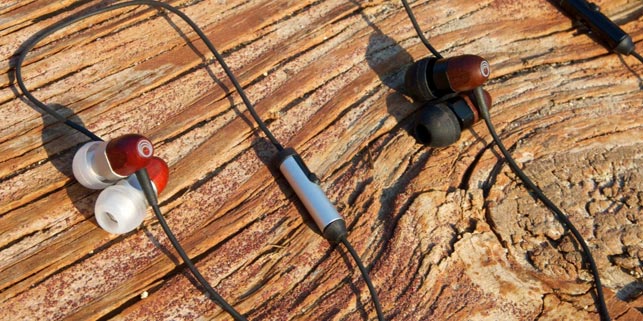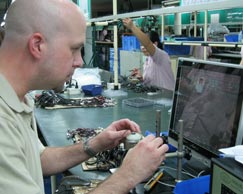Interview with thinksound founders Aaron Fournier and Mike Tunney
thinksound was founded by Aaron Fournier and Mike Tunney, who met while working for Tivoli Audio. At Tivoli Audio, Aaron was an audio engineer, and Mike was the creative director. The duo then collaborated on the launch of Sapphire Audio, where Aaron had the opportunity to work with industry legend Cary Christie (cofounder of Infinity and founder of Artison). Following that, Aaron was a Project Leader at Consumers Union, the publisher of Consumer Reports Magazine. His experience in reviewing and testing audio equipment is vital to the strict quality control process at thinksound.
After serving as Director of Engineering and Chief Sound Engineer at V-MODA, where he voiced and helped design some of the best-selling headphones on the market, Aaron re-teamed with Mike and began developing what would eventually become the first two products offered by thinksound; rain and ts01 in-ear headphones.

With the firm belief that its products should be designed and manufactured responsibly, without sacrificing quality or price, thinksound was launched. Clear sound with a clearer conscience is what we believe in.
thinksound began with a simple goal; to create incredible sounding headphones with the smallest eco-footprint possible. Our headphones are made with real wood, creating a more natural resonance and unparalleled acoustics. The products are crafted from recycled materials and with minimal plastic components. It’s also taken the decision to use PVC-free cables and choose the wood stock from renewable sources. To find out more, we caught up with thinksound’s CEO, Aaron Fournier to discuss the company’s attitude towards sustainabillity, how it managed to bring a new take on consumer audio electronics.
D3D: I guess a good place to start is the ideation – the consumer electronics industry is pretty well known for having a “less than exemplary” track record when it comes to sustainability and environmental damage. Where did the genesis for the product range come from?
Aaron Fournier: This came from designing in the past. I saw many ways that we could still make an attractive design and package but no one wanted to do it because it didn’t ‘fit’ their brand. I really felt that we could be successful in trying to make a more friendly product and a better sounding product and the results show and will continue to show as the thinksound brand grows.
D3D: Does your position as CEO and ultimate decision maker sit, combined with having a clear view on the whole process as an engineer, give you benefits over other engineers working in teams with multi-layers of management and perhaps facing many more corporate pressures? Any advice for those designers and engineers working for larger organizations that are keen to create sustainable products, but face an uphill struggle to get approval or management buy in?
Aaron Fournier: Yes. You would be shocked if you knew how many companies actually do not employ audio or acoustic engineers. Many companies out there are more worried about how many units they sell instead of focusing on how it sounds and how much a customer will appreciate the product. We aren’t trying to be a ‘cool’ or ‘hip’ company but rather try to focus audio and customer service back into the headphone industry. There are too many throw away headphones and lack of customer service from the consumer electronics industry. I personally lived in factories and in China and worked on production lines with workers working on products for years. There are many headphone companies whose employees or upper management have never visited their own factories. It really is embarrassment to the industry as a whole.
The whole idea to get some current companies to become greener is a tough one to deal with. I hate to say it but most companies won’t be green if it means spending more money. A perfect example to this is when we were at a medium sized trade show last year and we were approached by the organizers asking us if we would like to be in their ‘green’ section. I of course said I would love to be involved and then they told me that it would cost me double for a booth in that area. This is a perfect example of greenwashing by companies who are paying to show they are green. There are many certifications and logos we could stamp on our products but we refuse to do so since all of these companies charge for the use.
D3D: How did you go about sourcing the materials for ear-phones? Was there a predefined list of materials you’d found to be appropriate or did you talk to suppliers?
Aaron Fournier: This really came from experience. I lived in China for many years so I have a vast knowledge of who is responsible and who isn’t for suppliers. All materials were chosen based on how strong they are and how sustainable they are. Of course there is a balance to what materials are chosen as well making sure that the materials are strong enough to make the product last.
D3D: Wood in audio equipment is a mark of high-end design, but typically restricted to large scale components (thinking speakers etc). What gave you the idea of introducing that to more portable product forms?

Aaron Fournier: It was that exact reason. I was thinking ‘why aren’t headphones made from wood when loudspeakers and instruments are?’ My answer was simply because it was too difficult to make. I started researching making wooden headphones YEARS ago before I can remember seeing anything other than one company that makes wooden over ear headphones (we al know who that is). The technology really wasn’t there but I started making samples and it was very difficult. It took me years to get the designs finished while of course some factories started selling wooden designs before we launched as the idea spread throughout the Chinese manufacturing community. Overall the technology is now there and we have come up with great designs and will continue to do so. The acoustics of our designs are far more natural and have a much more natural resonance than plastic and other materials.
D3D: Did you conduct a Life Cycle Assessment on the products and their production/transportation? If so, how did you go about it?
Aaron Fournier: Not at this time. We are too small of a company to do this. I personally oversee all of the design aspects and I choose the best and most eco-friendly materials as possible. I believe life cycle assessment may be great for some larger companies but since I always have my hands in every aspect of the product then its not needed. I am the one who sees the product from cradle to grave so I know exactly what is going on at all times with the products. I personally even review all the defects so I know the return rates and what we can do to improve them.
D3D: While we’re discussing transportation, your products seem to have the eco-design aspects nailed, but what about production? Do you think it’s inevitable to maintain operating margins that such products will always been manufactured in lower-cost economies and that will always mean impact from transportation?
Aaron Fournier: This is a tough question. Manufacturing will always adapt to the lower economy. It is a world market now and people need to realize that. If it were easier and cheaper to manufacture in the USA then we certainly would but it is not. We just don’t have that market anymore. Manufacturing is always shifting locations and it really is up to the company to make sure things stay responsible.
D3D: The packaging concept is fascinating and sees you address one of the major issues with consumer electronics. How did you arrive at the end result?
Aaron Fournier: Once again this was just from experience. I hate blister packs and I don’t think they are needed. If a company says they will not sell our products without a blister then we will not be partners with them. It really is a simple design and way cheaper to use the design we use. There are a lot of companies that actually pay more for their packaging than their actual product which is insane.
D3D: Any lessons the team learned in the product’s development that you’d be willing to share to help others embarking on a sustainable design project?
Aaron Fournier: Be patient! Don’t give up on what you believe in. There is always a way to make a better product but you will need to adjust your methods over time. Making a quality product comes from experience. It would also be nice if other companies executives would get out once in a while and inspect their own factories instead of just buying a design off of a factory and stamping their name on it.
Interview with thinksound’s founder Aaron Fournier
No






